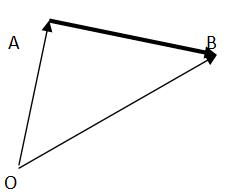Question 4: Define the following;
| Displacement | Position | Acceleration | Linear acceleration | Radial acceleration | Instantaneous acceleration |
ANSWER
Displacement: Displacement of a body from an initial point A to a final point B is defined as the straight directed distance from A to B.
Displacement is a vector quantity. It can be calculated as the difference of the initial and final position vectors of a body. In the adjacent figure, it is denoted by AB = rB – rA = Δr

The length of the line AB represents the magnitude of the displacement and
its direction is from A to B. It should be noted that the body could move from
A to B through any path, straight or curved, but the displacement is the
Δr that is the shortest distance vector.
SI unit of displacement is meter and dimension |L|.
Position: Position of a point is defined as the location of a point relative to some reference point, usually called origin.
Acceleration: The time rate of change of velocity is called acceleration.
If the velocity of a body changes by an amount Δv in a time interval Δt, then its average acceleration is given by,

The acceleration is said to be positive if the speed of the body increases with time and negative if the speed is decreasing. Negative acceleration is also called deceleration or retardation.
Uniform acceleration: Again, if equal change occurs in the velocity of a body in equal intervals of time, the acceleration is said to be uniform.
Variable acceleration: On the other hand, if the changes in velocity are unequal for equal intervals of time, the acceleration is said to be variable. For example, if the change in the velocity of the car you drive is 2 m in the first second and then you press the accelerator harder and it becomes 4 m in the 2nd second, then the change in the velocity is unequal for equal intervals of time.
Linear acceleration and radial accelerations: Velocity may change in two different ways, and hence acceleration is of two types.
Linear acceleration: The acceleration produced due to a change in the magnitude of the velocity, while the body is moving in a straight line, is called linear acceleration.
Radial acceleration: The acceleration produced by the change in the direction of the velocity of a body is called radial acceleration.
(Note: A body may have both type of accelerations at the same time).
Instantaneous acceleration: The acceleration of a body at a particular instant of time is known as instantaneous acceleration.
It is customary to reduce the time interval to a very small interval of time while calculating instantaneous acceleration. Mathematically,


Pingback:force-and-motion – msa